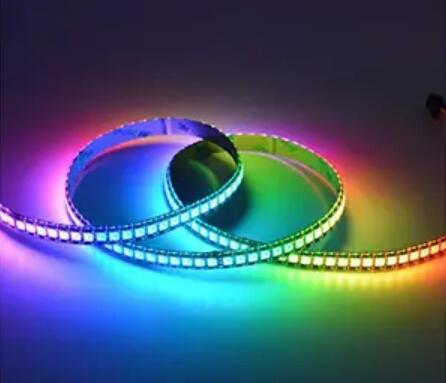Release time:Apr 07,2024View:27221
LED pixel tape, also known as addressable LED tape or pixel tape, works by combining individually addressable LEDs with flexible tape or strip material. Each LED on the tape can be controlled independently, allowing for dynamic lighting effects, animations, and color changes. Here's how it typically works:

LED Chips: LED pixel tape consists of small LED chips mounted on a flexible substrate, such as a strip of PCB (Printed Circuit Board) or flexible circuit material. These LED chips are usually RGB (Red, Green, Blue) or RGBW (Red, Green, Blue, White), allowing for a wide range of colors to be produced.
Control Circuitry: Each LED chip is typically accompanied by control circuitry, which includes a microcontroller or driver chip. This control circuitry is responsible for receiving data signals, interpreting them, and controlling the color and brightness of the corresponding LED.
Data Input: LED pixel tape is designed to receive data signals from a controller. These data signals determine the color, brightness, and behavior of each individual LED on the tape. The data is usually sent in serial format, using protocols such as SPI (Serial Peripheral Interface) or a specialized protocol like WS2812 (Neopixel) or APA102 (DotStar).
Addressing: Each LED on the pixel tape has a unique address, allowing the controller to communicate with them individually. This address can be assigned manually or automatically depending on the type of LED tape and controller used.
Controller: A separate controller device or microcontroller is used to generate the data signals that control the LED pixel tape. This controller can be programmed to produce various lighting effects, animations, and patterns by sending appropriate data to the tape.
Power Supply: LED pixel tape requires a power supply to operate. The power supply provides the necessary voltage and current to illuminate the LEDs. The power requirements vary depending on the length and type of LED tape used.
Installation: LED pixel tape is typically installed by adhering the flexible strip to a surface using adhesive backing or mounting clips. It can be cut to custom lengths at designated cut points along the strip, allowing for flexibility in installation.
Control Software: To control LED pixel tape, specialized software or programming tools are often used. This software allows users to create custom lighting sequences, color schemes, and animations, which are then translated into data signals sent to the LED tape via the controller.
Overall, LED pixel tape provides a versatile and customizable lighting solution suitable for a wide range of applications, including architectural lighting, stage lighting, decorative lighting, and visual displays. Its ability to produce intricate patterns and dynamic effects makes it a popular choice for lighting designers and enthusiasts alike.
Shenzhen, China 518103

